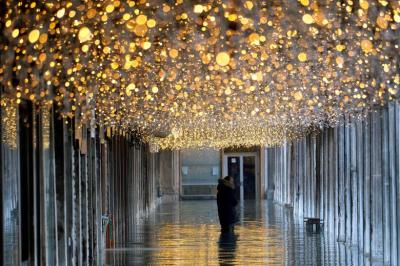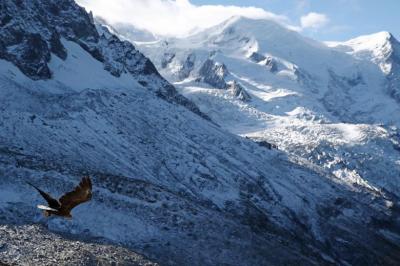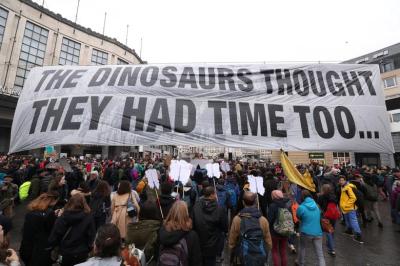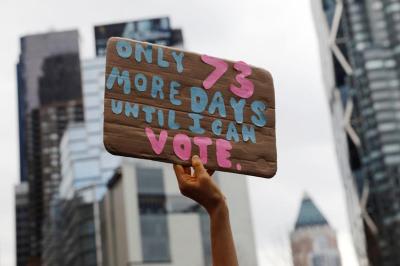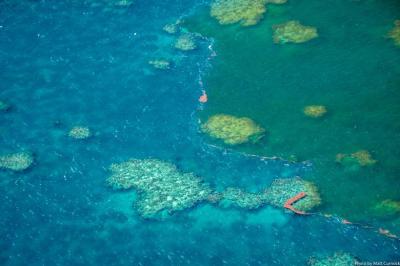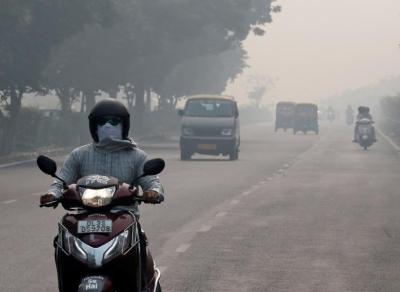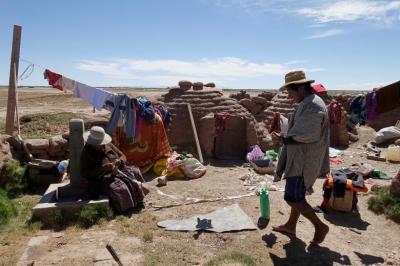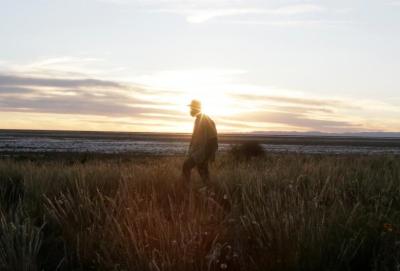Venice is flooded by high tides during the holidays, just a month after the Italian city suffered its worst week of flooding since records began in 1872. One month after Venice endured devastating high tides, The Associated Press reported on Monday that the Italian city is again facing exceptionally high-water levels. Toto Bergamo Rossi, director of the cultural foundation Venetian Heritage, called it “a prolonged emergency.” For many, many tourists who themselves often inundate the city, the flooding has provoked a more immediate question: Can we still go to Venice? The short answer is yes, even though some travelers appear to be worried: In November, Venice hotels reported a 35 percent cancellation rate, according to a local association, putting a dent into what is a €3 billion (about $3.3 billion) a year industry.
Category Climate change
Eagle eye view of the Alps
Victor, a 9-year-old white-tailed eagle, wears a 360 camera to capture its spectacular flights over glaciers and mountains and raise awareness of global warming. The Alps are the highest and most extensive mountain range system that lies entirely in Europe, and stretching approximately 1,200 kilometres (750 mi) across eight Alpine countries (from west to east): France, Switzerland, Monaco, Italy, Liechtenstein, Austria, Germany, and Slovenia. The mountains were formed over tens of millions of years as the African and Eurasian tectonic plates collided. Extreme shortening caused by the event resulted in marine sedimentary rocks rising by thrusting and folding into high mountain peaks such as Mont Blanc and the Matterhorn. Mont Blanc spans the French–Italian border, and at 4,810 m (15,781 ft) is the highest mountain in the Alps. The Alpine region area contains about a hundred peaks higher than 4,000 metres (13,000 ft).
The altitude and size of the range affects the climate in Europe; in the mountains precipitation levels vary greatly and climatic conditions consist of distinct zones. Wildlife such as ibex live in the higher peaks to elevations of 3,400 m (11,155 ft), and plants such as Edelweiss grow in rocky areas in lower elevations as well as in higher elevations. Evidence of human habitation in the Alps goes back to the Palaeolithic era. A mummified man, determined to be 5,000 years old, was discovered on a glacier at the Austrian–Italian border in 1991.
Students strike for climate change action
From Sydney to London, thousands of school students walked out of classes in a global student strike to protest against government inaction on climate change. School strike for climate, also known in various regions as Fridays for Future, Youth for Climate or Youth Strike 4 Climate, is a growing international movement of pupils and students who are deciding not to attend classes and instead take part in demonstrations to demand action to prevent further global warming and climate change. Publicity and widespread organising began when Greta Thunberg staged an action outside the Swedish Riksdag (parliament), holding a sign that read “Skolstrejk för klimatet” or “School strike for the climate” during August 2018.
Climate Strike 2015
In 2015, an independent group of students invited students around the world to skip school on the first day of COP 21, the UNFCCC Climate Conference. On 30 November, the first day of Climate Conference in Paris, ‘Climate Strike’ was organized in over 100 countries and joined by over 50000 people. The movement focused on three demands, 100% clean energy, keeping fossil fuels in the ground, and helping climate refugees.
Greta Thunberg and other early strikers in 2018
On 20 August 2018, Greta Thunberg, then in ninth grade, decided to not attend school until the 2018 Sweden general election on 9 September after heat waves and wildfires in Sweden. She asserts that this move was inspired by the teen activists at Parkland Marjory Stoneman Douglas High School in Florida, who organised the March for our lives. Her demands were that the Swedish government reduce carbon emissions per the Paris Agreement, and she protested by sitting outside the Riksdag every day during school hours with the sign Skolstrejk för klimatet (school strike for climate). On 7 September, just before the general elections, she announced that she would continue to strike every Friday until Sweden aligns with the Paris Agreement. She coined the slogan FridaysForFuture, which gained worldwide attention. She inspired school students across the globe to take part in student strikes.
Growing movement
Inspired by Greta Thunberg, massive school strikes started in November 2018. In Australia, thousands of school students were inspired by Thunberg to strike on Fridays, ignoring Prime Minister Scott Morrison’s call for “more learning in schools and less activism”. Galvanized by the COP 24 Climate Change Conference in Katowice, Poland, in December student strikes continued at least in 270 cities in countries including Australia, Austria, Belgium, Canada, the Netherlands, Germany, Finland, Denmark, Japan, Switzerland, the United Kingdom and the United States. In 2019, strikes were organised again in the countries listed above and were organised for the first time in other countries, notably: Colombia, New Zealand and Uganda.
Comments by school and government officials
The strikes have also been criticised as truancy. Prime Minister Theresa May of the United Kingdom criticised the strikes as wasting lesson and teaching time. Australian Prime Minister Scott Morrison called for “more learning and less activism” following the strikes. Australia’s Education Minister Dan Tehan suggested that if school students feel strongly about a cause, then they should protest in their own time in the evenings or on weekends. In New-Zealand, there was a mixed response from politicians, community leaders, and schools. Students were threatened to be marked as truant by some principals for attending the strike without their parents’ or schools’ permission. Judith Collins, and several other Members of Parliament were dismissive of the impact of the strike. However, the Climate Change Minister James Shaw was supportive of the strike, and defended the strike on a school day, saying: “When you’re fighting for your future, and you are trying to get the attention of those whom you feel have let you down, following the rules and marching on the weekend isn’t going to cut it.”
Why the Great Barrier Reef is in danger ?
The Great Barrier Reef Marine Park Authority considers the greatest threat to the Great Barrier Reef to be climate change, causing ocean warming which increases coral bleaching. Mass coral bleaching events due to elevated ocean temperatures occurred in the summers of 1998, 2002 and 2006, and coral bleaching is expected to become an annual occurrence. As global warming continues, corals will not be able to keep up with increasing ocean temperatures. Coral bleaching events lead to increased disease susceptibility, which causes detrimental ecological effects for reef communities.
In July 2017 UNESCO published in a draft decision, expressing serious concern about the impact of coral bleaching on the Great Barrier Reef. The draft decision also warned Australia that it will not meet the targets of the Reef 2050 report without considerable work to improve water quality. Climate change has implications for other forms of reef life—some fish’s preferred temperature range leads them to seek new habitat, thus increasing chick mortality in predatory seabirds. Climate change will also affect the population and sea turtle’s available habitat. Bleaching events in benthic coral communities (deeper than 20 metres or 66 feet) in the Great Barrier reef are not as well documented as those at shallower depths, but recent research has shown that benthic communities are just as negatively impacted in the face of rising ocean temperatures. Five Great Barrier Reef species of large benthic corals were found bleached under elevated temperatures, affirming that benthic corals are vulnerable to thermal stress.
Another key threat faced by the Great Barrier Reef is pollution and declining water quality. The rivers of north eastern Australia pollute the Reef during tropical flood events. Over 90% of this pollution comes from farm runoff. 80% of the land adjacent to the Great Barrier Reef is used for farming including intensive cropping of sugar cane, and major beef cattle grazing. Farming practices damage the reef due to overgrazing, increased run-off of agricultural sediments, nutrients and chemicals including fertilisers, herbicides and pesticides representing a major health risk for the coral and biodiversity of the reefs. Sediments containing high levels of copper and other heavy metals sourced from the Ok Tedi Mine in Papua New Guinea are a potential pollution risk for the far northern Great Barrier Reef and Torres Strait regions. Some 67% of corals died in the reef’s worst-hit northern section, the ARC Centre of Excellence for Coral Reef Studies report said.
The runoff problem is exacerbated by the loss of coastal wetlands which act as a natural filter for toxins and help deposit sediment. It is thought that the poor water quality is due to increased light and oxygen competition from algae. Farming fertiliser runoff release nitrogen, phosphorus, and potassium into the oceanic ecosystem, these limiting nutrients cause massive algal growth which leads to depletion in oxygen available for other creatures which decreases the biodiversity in the affected areas, altering the species composition. A study by Katharina Fabricius and Glen Death of Australian Institute of Marine Science found that hard corals numbers were almost double on reefs that were far from agricultural areas. Fertilizers also increase the amount of phytoplankton available for the crown-of-thorns starfish larvae to consume. A study showed that a doubling of the chlorophyll in the water leads to a tenfold increase in the crown-of-thorns starfish larvae’s survival rate.
Mining company Queensland Nickel discharged nitrate-laden water into the Great Barrier Reef in 2009 and 2011 – on the later occasion releasing 516 tonnes (508 long tons; 569 short tons) of waste water. The Great Barrier Reef Marine Park Authority (GBRMPA) stated “We have strongly encouraged the company to investigate options that do not entail releasing the material to the environment and to develop a management plan to eliminate this potential hazard; however, GBRMPA does not have legislative control over how the Yabulu tailings dam is managed”.
The unsustainable overfishing of keystone species, such as the Giant Triton, can disrupt food chains vital to reef life. Fishing also impacts the reef through increased water pollution from boats, by-catch of unwanted species (such as dolphins and turtles) and habitat destruction from trawling, anchors and nets. As of the middle of 2004, approximately one-third of the Great Barrier Reef Marine Park is protected from species removal of any kind, including fishing, without written permission.
Shipping accidents are a pressing concern, as several commercial shipping routes pass through the Great Barrier Reef. Although the route through the Great Barrier Reef is not easy, reef pilots consider it safer than outside the reef in the event of mechanical failure, since a ship can sit safely while being repaired. There have been over 1,600 known shipwrecks in the Great Barrier Reef region. On 3 April 2010, the bulk coal carrier Shen Neng 1 ran aground on Douglas Shoals, spilling up to four tonnes of oil into the water and causing extensive damage to the reef.
In March 2015, the Australian and Queensland’s governments formed a plan for the protection and preservation of the reef’s universal heritage until 2050. This 35 years plan, titled “Reef 2050 Plan” is a document proposing possible measures for the long-term management of the pollution, climate change and other issues that threaten the life span and value of this global heritage. The plan contains all the elements for measurement and improvements, including; long-term sustainability plan, water quality improvement plan and the investment plan for the protection and preservation of The Reef until 2050. However, whereas the 2050 plan aims to incorporate protective measures such as improving water quality, reef restoration, killing of predatory starfish, it does not incorporate additional measures to address the root cause the problem namely climate change (which is caused by greenhouse gas emissions). As such, experts doubt on whether it will be enough to save the fragile environment.
The Great Barrier Reef has long been known to and used by the Aboriginal Australian and Torres Strait Islander peoples. Aboriginal Australians have been living in the area for at least 40,000 years,and Torres Strait Islanders since about 10,000 years ago. For these 70 or so clan groups, the reef is also an important cultural feature. In 1768 Louis de Bougainville found the reef during an exploratory mission, but did not claim the area for the French. On 11 June 1770, HM Bark Endeavour, captained by explorer James Cook, ran aground on the Great Barrier Reef, sustaining considerable damage. Lightening the ship and re-floating it during an incoming tide eventually saved it. One of the most famous wrecks was HMS Pandora, which sank on 29 August 1791, killing 35 men. The Queensland Museum has led archaeological digs to wreck of Pandora since 1983. Because the reef had no atolls, it was largely unstudied in the 19th century. During this time, some of the reef’s islands were mined for deposits of guano, and lighthouses were built as beacons throughout the system. As in Raine Island, the earliest example. In 1922, the Great Barrier Reef Committee began carrying out much of the early research on the reef.
New Delhi becomes the capital of air pollution
The air quality in Delhi, the capital of India, according to a WHO survey of 1600 world cities, is the worst of any major city in the world. Air pollution in India is estimated to kill 1.5 million people every year; it is the fifth largest killer in India. India has the world’s highest death rate from chronic respiratory diseases and asthma, according to the WHO. In Delhi, poor quality air damages irreversibly the lungs of 2.2 million or 50 percent of all children. In November 2017, in an event known as the Great smog of Delhi, the air pollution spiked far beyond acceptable levels. Levels of PM2.5 and PM 10 particulate matter hit 999 micrograms per cubic meter, while the safe limits for those pollutants are 60 and 100 respectively.
Air quality or ambient/outdoor air pollution is represented by the annual mean concentration of particulate matter PM10 (particles smaller than 10 microns) and PM2.5 (particles smaller than 2.5 microns, about 25 to 100 times thinner than a human hair). The world’s average PM10 levels, for the period 2008 and 2013, based on data of 1600 cities in 91 countries, range from 26 to 208 micrograms per cubic meter of air (μg/m3), with the world average being 71 μg/m3. 13 of the 25 cities worldwide with the highest levels of PM are in India.
In 2010, the year of the WHO survey, the average PM10 level in Delhi was 286 μg/m3. In 2013, the PM2.5 level was 153 μg/m3. These levels are considered very unhealthy. In Gwalior, the city with the worst air quality in India, the PM10 and PM2.5 levels were 329 μg/m3 and 144 μg/m3 respectively. For comparison, the PM10 and PM2.5 levels in London were 22 μg/m3 and 16 μg/m3 respectively. The PM levels in Delhi have become worse since the WHO survey. In December–January 2015, in Delhi, an average PM2.5 level of 226 μg/m3 was noted by US embassy monitors in Delhi. The average in Beijing for the same period was 95. Delhi’s air is twice as bad as Beijing’s air. As of October 2017, experts in several monitoring stations have reportedly measured an air quality index (AQI) of 999. According to said experts this is the equivalent of smoking 45 to 50 cigarettes a day. This has led to some government officials, such as Arvind Kejriwal calling the nation’s capital a “gas chamber”.
Causes of poor air quality
Motor vehicle emissions are one of the causes of poor air quality. Other causes include wood-burning fires, fires on agricultural land, exhaust from diesel generators, dust from construction sites, and burning garbage.[9][10] and illegal industrial activities in Delhi. The Badarpur Thermal Power Station, a coal-fired power plant built in 1973, is another major source of air pollution in Delhi. Despite producing less than 8% of the city’s electric power, it produces 80 to 90% of the particulate matter pollution from the electric power sector in Delhi. During the Great smog of Delhi in November 2017, the Badarpur Power Plant was temporarily shut down to alleviate the acute air pollution, but was allowed to restart on 1 February 2018. Although Delhi is kerosene free and 90% of the households use LPG for cooking, the remaining 10% uses wood, crop residue, cow dung, and coal for cooking. (Census-India, 2012). Fire in Bhalswa landfill is a major reason for airborne particles in Delhi. Agricultural stubble burning also affects Delhi’s air quality when crops are being harvested. Lack of active monitoring and reaction by authorities. Lack of political priority.
Climate change threatens Bolivia
Rising temperatures in Bolivia s highlands have caused a sustained drought of the second largest lake in the country, forcing the indigenous community living around it to search for new ways of life. Poor women and men throughout Bolivia are already experiencing the consequences of climate change, but in most cases are ill-equipped to adapt to the present and future impacts. Women are often the hardest hit.
Bolivia can expect five main impacts as a result of climate change:
Less food security.
Glacial retreat affecting water availability.
More frequent and more intense ‘natural’ disasters.
An increase in mosquito-borne diseases.
More forest fires.


